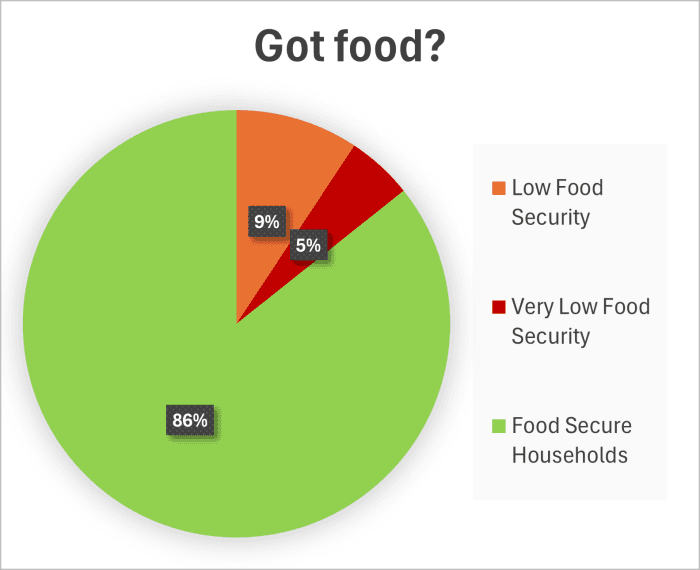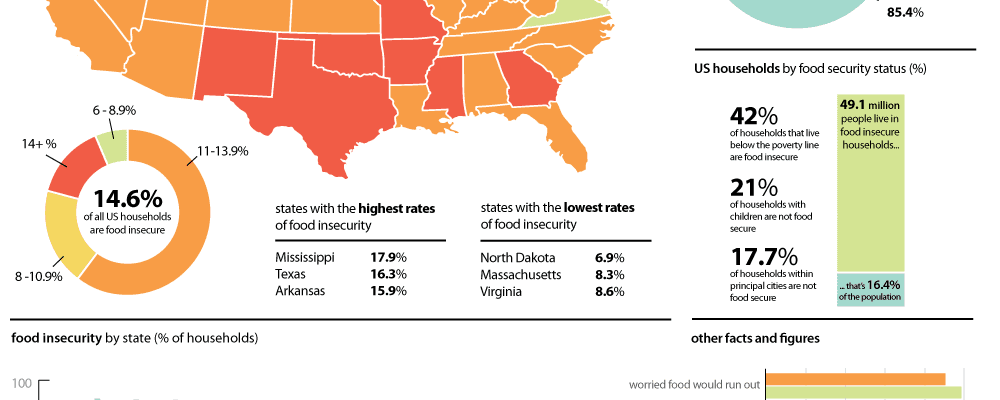
For nearly 20 years now I’ve been hearing about how 1 in 5 children in the US are starving. We have food stamps, food banks, food pantries, soup kitchens, and billions of dollars go to food-based charities every year. How can there be starving children here?
We must do better.
I agree, there is no reason to go hungry here. I mentioned many reasons above. Let’s go through them:
Food Stamps: The Supplemental Nutrition Assistance Program (SNAP) provides money to low-or-no-income folk to pay for food. The Federal Government has an annual budget of $50 billion for this program. 9.2% of US households (~11.8m households) have SNAP covering 16.7% of all children in the US (~12.4m children). That’s ~$350/month for each of those households.
Food Banks: A specific type of not-for-profit company that is like a hub for food donation charity. Local charities collect food donations and send them to food banks to be distributed to food pantries, soup kitchens, etc. They often have services to help people apply for SNAP.
Food Pantries: Small store-like places that offer food and other necessary supplies to those who need them.
Soup Kitchens: The more colloquial term for a small restaurant-like place where food is cooked and served at no-cost to those in need.
Government Expenditures: The US Government spent $182.5 billion on federal food programs (including Food Stamps). States will often add more to this pot.
Food-Based Charity: I couldn’t get a breakout of where the money goes so I assume food banks, food pantries, and soup kitchens are included. US citizens donate a lot, but it’s hard to pin down a number. The top 300 food banks received $16 billion in donations (2023) but there are tens-of-thousands receiving donations.
To sum up we can conservatively say that over $200 billion is going to feed folk in the US, that’s $600/year per person in the US. If we’re only helping 20% of our people, $250/month should be enough to feed a person, especially a child.
That’s a lot of money.
Yeah, so why do I keep hearing that 1 in 5 children are starving? I looked into this statistic decades ago when I first heard it. It sounded wrong, not like “hmm that’s interesting” wrong, more like “that’s a pretty bold lie you’re telling right there” kind of wrong.
Surely they wouldn’t lie.
Look, people want to help people. This is good. Keep doing it. Find more ways to do it. And when children are involved, we perk up our ears even more and become indignant. So when the government comes out with a statistic we listen, because they used science to get to that number and it’s right.
Is it though?
Kinda. There is a survey conducted by the Federal Government:
Current Population Survey (CPS): This is a US Census report with a supplemental questionnaire provided by the USDA and ERS where they ask questions about food.
This includes questions like:
- In the last 12 months did you or other adults in your household ever not eat for a whole day because there wasn’t enough money for food?
- In the last 12 months, did you lose weight because there wasn’t enough money for food?
- In the last 12 months, did any of the children ever skip a meal because there wasn’t enough money for food?
Sounds pretty bad to me.
These questions focus on incidents of hunger based on money. Were you ever at the end of the month, forgot to pack lunch, and you don’t have money to get lunch? You missed a meal in those 12 months, this means you have low food security, the official status of the 1 in 5 starving children referenced. To make the 1 in 5 statistic you need to answer affirmatively to all these three:
- You are worried whether your food would run out before you got money to buy more.
- The food you bought didn’t last, and you didn’t have money to get more.
- You couldn’t afford to eat balanced meals.
Every college student meets those criteria above.
Everybody’s starving?
It would seem so. They did add another definition in 2006: very low food security. While still a little too ambiguous for my taste, it is a much better measure than low food security. The criteria here includes:
- Adults ate less than they felt they should.
- Adults cut the size of meals or skipped meals and did so in 3 or more months.
- Children did not eat for a whole day in 3 or more months.
Now that’s a problem that needs fixing.
Goodness, how many is that?
The most recent data (2023) shows that 16.5 million (5%) US households have very low food security and 1.2% of all US children have very low food security. That’s 875,000 children. Still waaay to high.


Mobilize all the foods!
Hold on, there’s enough food, everywhere. It’s already available and being distributed. Low incomes and high housing costs aside: the lack of education, the stigma of poverty, drug use, and disability are major contributors to parental neglect:
- Pride – Someone who was doing well, but down on their luck is less likely to apply for assistance. I’ve heard food-stamps and food-bank related insults being flung about. Toughing it out might be something they choose instead of applying. Though I suspect it’s more likely they don’t expect whatever hardship they’re in to last as long as it has.
- Education – I’ve recommended food stamps and food banks to people only to get puzzled stares. They didn’t know these options existed or how easy it was to qualify.
- Drug Use – Yeah, this goes without saying. People on drugs forget to take care of themselves as well as their kids.
- Disability – ADHD, Depression, and ASD can all inhibit daily function to the degree of disability. These disabilities can prevent the application to available services.
How do we fix this?
Well, with the reduction in food bank funding by the Trump administration we need to continue to donate to these systems. But we also need to:
- Donate! Yeah, keep sending your money to the food banks.
- Promote! We need to de-stigmatize getting access to these food sources. No shame in eating donated food. Someone loved you enough to contribute, don’t let them down.
- Educate! Everyone should know how to access these services. I recommend telling people to go directly to the food banks. They’ll be able to point people in the right direction.
- Volunteer! Food banks, food pantries, and “soup kitchens” all need help. Find one and they can point you to the rest. Love your neighbors.
- Politic! Vote for people who support these systems. Complain to people who don’t.
Is that it?
Stop using the 1 in 5 statistic. It’s not reality. Try “850,000 kids missed three meals in a row last year” or “kids were hungry for more than 2 million full days last year.” Those are accurate and equally horrifying.
References (do your own research!):
